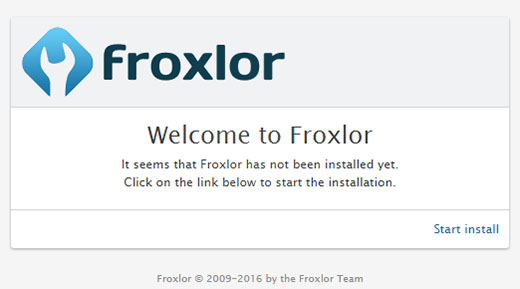
In this tutorial, we will show you how to install Froxlor on Ubuntu 20.04 LTS. For those of you who didn’t know, Froxlor is an open-source lightweight server management control panel to effectively manage web hosting, domain names, FTP accounts, email accounts, support tickets, and customers that are associated with them and are licensed under GPL.
This article assumes you have at least basic knowledge of Linux, know how to use the shell, and most importantly, you host your site on your own VPS. The installation is quite simple and assumes you are running in the root account, if not you may need to add ‘sudo‘ to the commands to get root privileges. I will show you the step-by-step installation of the Froxlor server management panel on Ubuntu 20.04 (Focal Fossa). You can follow the same instructions for Ubuntu 18.04, 16.04, and any other Debian-based distribution like Linux Mint.
Prerequisites
- A server running one of the following operating systems: Ubuntu 20.04, 18.04, 16.04, and any other Debian-based distribution like Linux Mint.
- It’s recommended that you use a fresh OS install to prevent any potential issues.
- SSH access to the server (or just open Terminal if you’re on a desktop).
- A
non-root sudo useror access to theroot user. We recommend acting as anon-root sudo user, however, as you can harm your system if you’re not careful when acting as the root.
Install Froxlor on Ubuntu 20.04 LTS Focal Fossa
Step 1. First, make sure that all your system packages are up-to-date by running the following apt commands in the terminal.
sudo apt update sudo apt upgrade sudo apt install apt-transport-https lsb-release ca-certificates gnupg
Step 2. Installing the LAMP stack.
A Ubuntu 20.04 LAMP server is required. If you do not have LAMP installed, you can follow our guide here.
Step 3. Installing Froxlor on Ubuntu 20.04.
Now we add the Froxlor repository to Ubuntu:
nano /etc/apt/sources.list.d/froxlor.list
Then, run the following command to add the package source:
echo 'deb http://debian.froxlor.org stretch main' > /etc/apt/sources.list.d/froxlor.list
Next, add a key for Froxlor:
apt-key adv --keyserver pool.sks-keyservers.net --recv-key FD88018B6F2D5390D051343FF6B4A8704F9E9BBC
Once done, install Froxlor on Ubuntu by running the following command below:
sudo apt install update sudo apt install upgrade sudo apt install froxlor
Step 4. Configuring MariaDB for Froxlor.
By default, MariaDB is not hardened. You can secure MariaDB using the mysql_secure_installation script. you should read and below each step carefully which will set a root password, remove anonymous users, disallow remote root login, and remove the test database and access to secure MariaDB:
mysql_secure_installation
Configure it like this:
- Set root password? [Y/n] y - Remove anonymous users? [Y/n] y - Disallow root login remotely? [Y/n] y - Remove test database and access to it? [Y/n] y - Reload privilege tables now? [Y/n] y
Next, we will need to log in to the MariaDB console and create a database for the Froxlor. Run the following command:
mysql -u root -p
This will prompt you for a password, so enter your MariaDB root password and hit Enter. Once you are logged in to your database server you need to create a database for Froxlor installation:
mysql> create database froxlor; mysql> create user 'froxlor'@'localhost' IDENTIFIED BY 'your-passwd'; mysql> GRANT ALL PRIVILEGES ON froxlor.* TO 'froxlor'@'localhost' IDENTIFIED BY 'your-passwd' WITH GRANT OPTION; mysql> flush privileges; mysql> exit;
Step 5. Configure Apache.
Now we create a new virtual host directive in Apache. For example, create a new Apache configuration file named ‘froxlor.conf’ on your virtual server:
sudo nano /etc/apache2/sites-available/froxlor.conf
Add the following lines:
<VirtualHost *:80>
ServerAdmin admin@example.com
DocumentRoot /var/www/html
ServerName your-domain.com
<Directory /var/www/html/>
Options FollowSymlinks
AllowOverride All
Require all granted
</Directory>
ErrorLog ${APACHE_LOG_DIR}/error.log
CustomLog ${APACHE_LOG_DIR}/access.log combined
</VirtualHost>
Now, we can restart the Apache webserver so that the changes take place:
sudo a2enmod rewrite sudo a2ensite froxlor.conf sudo systemctl restart apache2.service
Step 6. Configure Firewall.
In case, you enabled firewall and firewall block requests of the Apache web server, open a port in the firewall:
sudo ufw allow 80/tcp sudo ufw allow 443/tcp sudo ufw reload
Step 7. Accessing Froxlor Web Interface.
Once successfully installed, now open your web browser and type the URL https://your-domain.com. You will be redirected to the following page.

Congratulations! You have successfully installed Froxlor. Thanks for using this tutorial for installing the Froxlor server management control panel on Ubuntu 20.04 LTS Focal Fossa system. For additional help or useful information, we recommend you check the official Froxlor website.